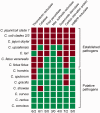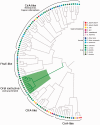Genomic evidence for the emergence and evolution of pathogenicity and niche preferences in the genus Campylobacter
- PMID: 25193310
- PMCID: PMC4202331
- DOI: 10.1093/gbe/evu195
Genomic evidence for the emergence and evolution of pathogenicity and niche preferences in the genus Campylobacter
Abstract
The genus Campylobacter includes some of the most relevant pathogens for human and animal health; the continuous effort in their characterization has also revealed new species putatively involved in different kind of infections. Nowadays, the available genomic data for the genus comprise a wide variety of species with different pathogenic potential and niche preferences. In this work, we contribute to enlarge this available information presenting the first genome for the species Campylobacter sputorum bv. sputorum and use this and the already sequenced organisms to analyze the emergence and evolution of pathogenicity and niche preferences among Campylobacter species. We found that campylobacters can be unequivocally distinguished in established and putative pathogens depending on their repertory of virulence genes, which have been horizontally acquired from other bacteria because the nonpathogenic Campylobacter ancestor emerged, and posteriorly interchanged between some members of the genus. Additionally, we demonstrated the role of both horizontal gene transfers and diversifying evolution in niche preferences, being able to distinguish genetic features associated to the tropism for oral, genital, and gastrointestinal tissues. In particular, we highlight the role of nonsynonymous evolution of disulphide bond proteins, the invasion antigen B (CiaB), and other secreted proteins in the determination of niche preferences. Our results arise from assessing the previously unmet goal of considering the whole available Campylobacter diversity for genome comparisons, unveiling notorious genetic features that could explain particular phenotypes and set the basis for future research in Campylobacter biology.
Keywords: Campylobacter; Campylobacter sputorum; comparative genomics; niche preferences; pathogenicity.
© The Author(s) 2014. Published by Oxford University Press on behalf of the Society for Molecular Biology and Evolution.
Figures








Similar articles
-
Comparative genomics of Campylobacter concisus: Analysis of clinical strains reveals genome diversity and pathogenic potential.Emerg Microbes Infect. 2018 Jun 26;7(1):116. doi: 10.1038/s41426-018-0118-x. Emerg Microbes Infect. 2018. PMID: 29946138 Free PMC article.
-
Genomic investigation into strain heterogeneity and pathogenic potential of the emerging gastrointestinal pathogen Campylobacter ureolyticus.PLoS One. 2013 Aug 30;8(8):e71515. doi: 10.1371/journal.pone.0071515. eCollection 2013. PLoS One. 2013. PMID: 24023611 Free PMC article.
-
Pathogenomics of Emerging Campylobacter Species.Clin Microbiol Rev. 2019 Jul 3;32(4):e00072-18. doi: 10.1128/CMR.00072-18. Print 2019 Sep 18. Clin Microbiol Rev. 2019. PMID: 31270126 Free PMC article. Review.
-
Comparative genomics and genome biology of Campylobacter showae.Emerg Microbes Infect. 2019;8(1):827-840. doi: 10.1080/22221751.2019.1622455. Emerg Microbes Infect. 2019. PMID: 31169073 Free PMC article.
-
Campylobacter virulence and survival factors.Food Microbiol. 2015 Jun;48:99-108. doi: 10.1016/j.fm.2014.11.017. Epub 2014 Dec 25. Food Microbiol. 2015. PMID: 25790997 Review.
Cited by
-
Comprehensive evaluation of methods for differential expression analysis of metatranscriptomics data.Brief Bioinform. 2023 Sep 20;24(5):bbad279. doi: 10.1093/bib/bbad279. Brief Bioinform. 2023. PMID: 37738402 Free PMC article.
-
Biochemical and molecular characterization of Campylobacter fetus isolates from bulls subjected to bovine genital campylobacteriosis diagnosis in Spain.BMC Vet Res. 2024 Apr 2;20(1):131. doi: 10.1186/s12917-024-03970-8. BMC Vet Res. 2024. PMID: 38566185 Free PMC article.
-
Updating the genomic taxonomy and epidemiology of Campylobacter hyointestinalis.Sci Rep. 2018 Feb 5;8(1):2393. doi: 10.1038/s41598-018-20889-x. Sci Rep. 2018. PMID: 29403020 Free PMC article.
-
Distinct Campylobacter fetus lineages adapted as livestock pathogens and human pathobionts in the intestinal microbiota.Nat Commun. 2017 Nov 8;8(1):1367. doi: 10.1038/s41467-017-01449-9. Nat Commun. 2017. PMID: 29118316 Free PMC article.
-
Guide-free Cas9 from pathogenic Campylobacter jejuni bacteria causes severe damage to DNA.Sci Adv. 2020 Jun 17;6(25):eaaz4849. doi: 10.1126/sciadv.aaz4849. eCollection 2020 Jun. Sci Adv. 2020. PMID: 32596446 Free PMC article.
References
-
- Alfredson DA, Korolik V. Antibiotic resistance and resistance mechanisms in Campylobacter coli and Campylobacter jejuni. FEMS Microbiol Lett. 2007;277:123–132. - PubMed
-
- Asakura M, et al. Comparative analysis of cytolethal distending toxin (cdt) genes among Campylobacter jejuni, C. coli and C. fetus strains. Microb Pathog. 2007;42:174–183. - PubMed
MeSH terms
Substances
Associated data
- Actions
Grants and funding
LinkOut - more resources
Full Text Sources
Other Literature Sources
Medical
Molecular Biology Databases

